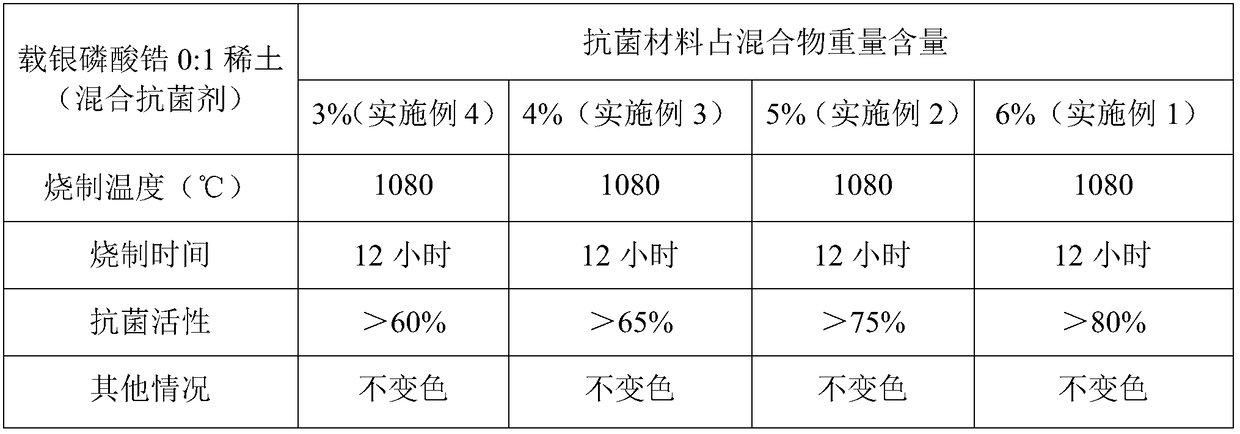Antibacterial ceramic manufacturing process
A manufacturing process, technology of antibacterial ceramics, applied in the field of antibacterial ceramics manufacturing process, can solve the problems of antibacterial materials burning loss, affecting appearance, low firing temperature, etc., and achieve simple production steps, long service life and high antibacterial effect
- Summary
- Abstract
- Description
- Claims
- Application Information
AI Technical Summary
Problems solved by technology
Method used
Image
Examples
Embodiment 1
[0025] A manufacturing process of antibacterial ceramics, (a) deploying glaze powder; (b) taking the glaze powder, and then adding antibacterial materials to form a mixture, so that the weight of the glaze powder is 94% of the total weight of the mixture; (c) stirring the mixture; ( d) ball milling the mixture; (e) screening the mixture through a 325-mesh sieve to screen out particles with a particle size smaller than or equal to 325 mesh to obtain antibacterial glaze powder; (f) adding the antibacterial glaze powder to water and stirring to obtain antibacterial glaze water; (g) spraying antibacterial glaze water on the porcelain body, which is a prefabricated ceramic body; (h) putting the porcelain body treated in step g into a kiln at 1080° C. for firing.
[0026] The glaze powder component in step a includes potassium feldspar, kaolin, zircon powder, quartz, calcite, zinc oxide, talc, barium carbonate, boric acid; Silver; the ball milling time of step d is 24h; in step e, r...
Embodiment 2
[0028] A manufacturing process of antibacterial ceramics, (a) deploying glaze powder; (b) taking the glaze powder, and then adding antibacterial materials to form a mixture, so that the weight of the glaze powder is 95% of the total weight of the mixture; (c) stirring the mixture; ( d) ball milling the mixture; (e) screening the mixture through a 325-mesh sieve to screen out particles with a particle size smaller than or equal to 325 mesh to obtain antibacterial glaze powder; (f) adding the antibacterial glaze powder to water and stirring to obtain antibacterial glaze water; (g) spraying antibacterial glaze water on the porcelain body; (h) putting the porcelain body treated in step g into a kiln at 1080° C. for firing.
[0029] The glaze powder component in step a includes potassium feldspar, kaolin, zircon powder, quartz, calcite, zinc oxide, talc, barium carbonate, boric acid; Silver; the ball milling time of step d is 24h; in step e, re-add the particles with a particle siz...
Embodiment 3
[0031] A manufacturing process of antibacterial ceramics, (a) deploying glaze powder; (b) taking the glaze powder, and then adding antibacterial materials to form a mixture, so that the weight of the glaze powder is 96% of the total weight of the mixture; (c) stirring the mixture; ( d) ball milling the mixture; (e) screening the mixture through a 325-mesh sieve to screen out particles with a particle size smaller than or equal to 325 mesh to obtain antibacterial glaze powder; (f) adding the antibacterial glaze powder to water and stirring to obtain antibacterial glaze water; (g) spraying antibacterial glaze water on the porcelain body; (h) putting the porcelain body treated in step g into a kiln at 1080° C. for firing.
[0032] The glaze powder component in step a includes potassium feldspar, kaolin, zircon powder, quartz, calcite, zinc oxide, talc, barium carbonate, boric acid; Silver; the ball milling time of step d is 24h; in step e, re-add the particles with a particle siz...
PUM
| Property | Measurement | Unit |
|---|---|---|
| Particle size | aaaaa | aaaaa |
| Particle size | aaaaa | aaaaa |
Abstract
Description
Claims
Application Information
 Login to View More
Login to View More - R&D
- Intellectual Property
- Life Sciences
- Materials
- Tech Scout
- Unparalleled Data Quality
- Higher Quality Content
- 60% Fewer Hallucinations
Browse by: Latest US Patents, China's latest patents, Technical Efficacy Thesaurus, Application Domain, Technology Topic, Popular Technical Reports.
© 2025 PatSnap. All rights reserved.Legal|Privacy policy|Modern Slavery Act Transparency Statement|Sitemap|About US| Contact US: help@patsnap.com



